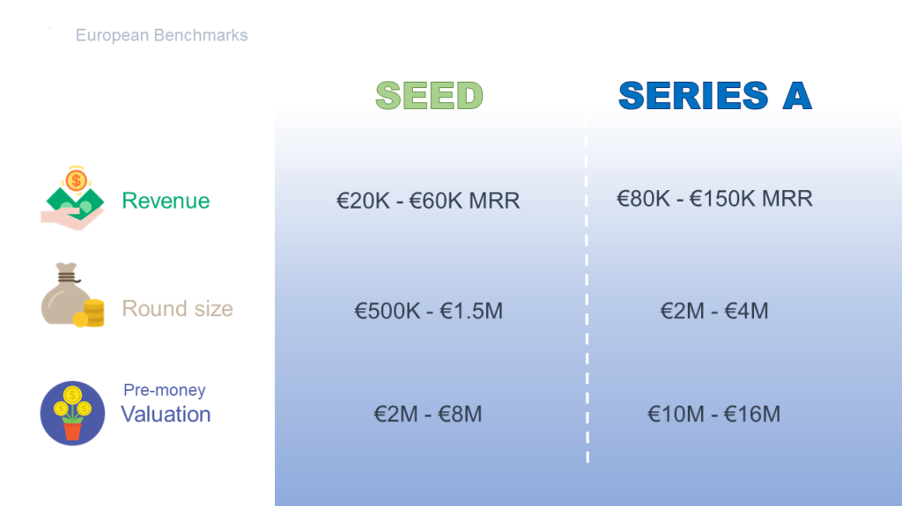Learn How to Speak VC in 7 minutes
Have you ever been in a discussion with someone who’s every second word was jargon (fine – maybe not every second word, but at least a couple) while you were hesitating to ask what language are they speaking?
In this article, we will provide you with the “translation” of some useful VC (Venture Capital – just to set the right tone) jargon and acronyms that might come in handy!
VC General
- Seed = Seed Financing – the first stage of financing that helps in the early development of a new product or service
- Series A = Series A Financing – the first significant round of venture capital financing that a company raises following seed capital

- Angel = Angel Investor – an individual who invests in startups
- IPO = Initial Public Offering – when a company offers its shares to the public markets and gets listed
- KPIs = Key Performance Indicators – a set of main metrics that indicate the performance of a company e.g. MRR (see definition below), New users, Churned customers, etc.
- OKRs = Objectives and Key Results – a framework for defining and tracking objectives and their outcomes
- Churn = Churn rate – the percentage of users who stopped being customers over a specific period (please note that these users may come back)
- Retention = Retention rate – the opposite of Churn i.e. the percentage of users who continued being customers over a specific period
- Cohort = A related group of people – for example, rather than looking at all users as one unit cohorts break them into related groups within a defined time-span for analysis purposes e.g. “the cohort of users that joined in August”
VC Legal
- TS = Term Sheet – a short non-binding document signed by investors that summarises the main commercial terms of an investment agreement. It serves as a basis for lawyers when drafting the extended investment agreements
- Shareholders = Share Holders – the individuals or companies that have shares in a company
- SHA = Shareholders Agreement – the contract defining the obligations and relationship between the company and the shareholders
- AoA = Articles of Association – a document that forms the company’s constitution, defines the purpose and specifies the regulations for its operations
- CT = Cap Table or Capitalization Table – a table that provides the details of the shareholders, the percentage and what type of shares they hold
- PPS = Price Per Share – the price paid in order to acquire one share in a company
- Pre Money = Pre Money Valuation – the valuation of the company before a capital increase (i.e. financing round) that determines the PPS for the round
- Post Money = Post Money Valuation – the Pre Money + the amount of capital injection e.g. a company with a Pre Money of €4M raising €1M would have a Post Money of €5M
- Fully Diluted = Fully Diluted Equity – the sum of already issued shares + any other outstanding instruments that could be converted into shares, such as stock options, convertible bonds, and warrants
- Liquidation Pref = Liquidation Preference – the right of certain shareholders (who hold a certain type of shares) to have priority and be the ones who get their capital back before any other shareholders in case of a liquidity event (such as a sale of the company)
- Pro-rata = A Latin term meaning in proportion – for example in case of a capital increase the pro-rata would refer to the right of a shareholder to purchase shares equal to the percentage the shareholder holds at the time of such financing
- Participating = Participating Liquidation Preference (also known as “Double Dipping”, for food lovers) – the right of certain shareholders to have priority in getting their pro-rata payoff on top of the Liquidation Preference
- Pre-emption = Pre-emption rights – when new shares of a company are issued shareholders with such rights have the option to buy those shares before they are offered to new investors. In this way, they can retain their percentage in a company and not be diluted
- ROFR = Right of First Refusal – when a shareholder wishes to sell existing shares, then shareholders who have a ROFR have the right but not the obligation (i.e. the option) to buy those shares, at the same PPS, before they are offered to new investors
- ESOP = Employee Stock Ownership Plan – a plan designated to allocate stock options to employees, contractors, and consultants. ESOP is used by companies in order to attract talent, incentivize employees and align their interest with shareholders
- LPs = Limited Partners – the investors of the VC funds
- GPs = General Partners or Partners – the managers of the VC funds who are responsible for the allocation of the investments
General Financial
- MRR = Monthly Recurring Revenues – the monthly predictable revenue that SaaS (Software as a Service) and subscription-based companies generate
- ARR = Annual Recurring Revenues – the annualized revenue derived by multiplying the MRR x 12
- GMV = Gross Merchandise Value – the total sales monetary value for merchandise sold through a particular marketplace
- CoGS = Cost of Goods Sold – the direct costs linked to the production of the goods (or services) sold by a company
- GP = Gross Profit – derived by subtracting Cost of Goods Sold from revenue
- GM = Gross Profit Margin – the Gross Profit as a percentage of revenue
- EBITDA = Earnings Before Interests Taxes Depreciation Amortization – used as a proxy for the earning potential of a company
- CapEx = Capital Expenditure – expenditure by a company to acquire or maintain physical assets such as property, buildings or equipment
- R&D = Research and Development – the work and resources a company puts towards developing new services or products or improving existing ones
- OpEx = Operating Expense – a day-to-day expense that a company incurs through its normal business operations (such as rent, inventory costs, marketing, payroll)
- G&A = General and Administrative Expense – expenses that fall under OpEx
- P&L = Profit and Loss Statement (also known as Income Statement) – a financial statement that summarizes the revenues, costs, and expenses attributed to a specific period
- BS = Balance Sheet – a financial sheet that reports a company’s assets, liabilities and shareholders’ equity at a specific point in time. It provides a snapshot of what a company owns, owes as well as the amount invested by shareholders
- CS = Cashflow Statement – a financial statement that provides information regarding the flow of cash in and out of the company during a given period
- MoM = Month over Month – compares one month with the previous one
- YoY = Year over Year – compares one period with the same period one year ago
- Q1 - Q4 = 1st Quarter of the year, 2nd Quarter of the year etc.
- H1 - H2 = 1st Half of the year, 2nd Half of the year
- FY = Fiscal Year – a period that a company uses for preparing its financial statements. This does not necessarily coincide with the calendar year
- YTD = Year To Date
- LTM = Last Twelve Months
- CAGR = Compound Annual Growth Rate – the average annual growth rate over a specified period of time longer than one year (in other words if a number has grown from X to Y over Z number of years what would have been the average growth rate per year in order to reach Y starting from X)
VC Financial
- ROI = Return On Investment – measures the amount of return on an investment relative to the investment’s costs. The return on investment formula is Gain from Investment – Cost of Investment / Cost of Investment
- Valuation Multiple = Company Valuation now / Company Valuation at the time of initial investment. However, Valuation Multiple can also refer to the "multiple approach" i.e. a multiplier applied on ARR for example in order to derive a company’s Pre Money Valuation
- Go to Market = Go to market strategy – the plan of a company on how to deliver their product or service and penetrate a (new) market
- IRR = Internal Rate of Return – estimates the implied percentage return of an investment
- EV = Enterprise Value – the sum of the equity value + debt value (net of cash). It can be thought of as the theoretical takeover price of a company
- AUM = Assets Under Management – the sum of committed LP capital across all funds of a VC (in other words the total amount the VC is managing)
- MF = Management Fees – fixed % of the AUM through which VCs cover their fixed running costs
- Carry = Performance Fees – performance compensation % that the GPs of a VC fund receive. This tightly aligns the fund managers with their LPs as the majority of the compensation typically comes from the Carry.

- UNICORN = A legendary creature with a single large horn OR a startup company with a valuation over $1 billion – companies that do reach the $1 billion mark are so rare that finding one is as difficult as finding a mythical unicorn
If you made it to the last definition then either you found the article useful, or you actually managed to make it, BIG TIME! ;)
Subscribe to newsletter
Get a bi-monthly email with news, interesting reads, and useful tips about startups.More Articles
from our Blog
Supported by InnovFin Equity, with the financial backing of the European Union under Horizon 2020 Financial Instruments and the European Fund for Strategic Investments (EFSI) set up under the Investment Plan for Europe. The purpose of EFSI is to help support financing and implementing productive investments in the European Union and to ensure increased access to financing.
Attention! This investment falls outside AFM supervision. No licence and no prospectus required for this activity!